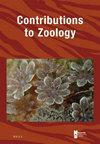南琉球的匍匐茎的八珊瑚,Hanabira yukibana, gen. nov., sp. nov.具有形态和共生变异
IF 2.1
2区 生物学
Q1 ZOOLOGY
引用次数: 6
摘要
八栖珊瑚(刺胞目:珊瑚虫目:八栖珊瑚目:Alcyonacea)是琉球(日本南部)一个相对未被开发的动物群,已知是一个具有高度生物多样性和特有物种的热带海洋地区。在冲绳县两个岛(冲绳岛和伊洛摩岛)海岸的野外调查中采集了匍匐茎的八爪珊瑚标本。尽管它们在表型上存在差异,但本研究显示了它们在形态和分子上的独特性,导致了一个新属的描述:Hanabira yukibana, gen. nov., p. nov.。它们被放置在Clavulariidae中,并与KnopiaAlderslade & McFadden, 2007和Clavularia Blainville, 1830形成了一个姐妹分支。该新种的珊瑚虫在形态和硬膜密度上均有差异,但在典型的整体花瓣状触须上具有融合小叶(假小叶)的一致性。根据它们的硬膜和共生科的光合内共生藻类(虫黄藻)的密度,它们的触手上有一种特有的光泽。此外,我们的标本所寄主的虫黄藻形成了一个清晰的小尺度生物地理格局;来自冲绳岛的所有yukibana标本均含有Cladocopium Lajeunesse和H. j . Jeong, 2018(=前共生菌纲' Clade C '),来自Iriomote岛的所有标本均含有Durusdinium Lajeunesse, 2018(=前共生菌纲' Clade D ')。这些结果表明,共生科植物群在八珊瑚中存在潜在的变异,这一点尚未对绝大多数虫黄藻类八珊瑚物种进行调查。本文章由计算机程序翻译,如有差异,请以英文原文为准。
The stoloniferous octocoral, Hanabira yukibana, gen. nov., sp. nov., of the southern Ryukyus has morphological and symbiont variation
Stoloniferan octocorals (Cnidaria: Anthozoa: Octocorallia: Alcyonacea) are a relatively unexplored fauna in the Ryukyus (southern Japan), known to be a tropical marine region of high biodiversity and endemism of species. Specimens of stoloniferous octocorals were collected during fieldwork along the coasts of two islands (Okinawa and Iriomote) in the Okinawa Prefecture. Despite their phenotypic polyp variation, this study shows their morphological and molecular uniqueness, leading to the description of a new genus with a single species: Hanabira yukibana, gen. nov., sp. nov. They are placed within the Clavulariidae and form a sister clade basally to the genus Knopia
Alderslade & McFadden, 2007 and species of Clavularia Blainville, 1830. The polyps of this new species show morphological variation in both shape and sclerite density, but there is conformity in the typical overall petal shaped tentacles, which have fused pinnules (pseudopinnules). Depending on the densities of their sclerites and their photosynthetic endosymbiotic algae (zooxanthellae) of the family Symbiodiniaceae, there is a characteristic sheen present in the tentacles. Moreover, the zooxanthellae hosted by our specimens form a clear, small-scale biogeographic pattern; all H. yukibana specimens from Okinawa Island contained zooxanthellae of the genus Cladocopium Lajeunesse & H.J. Jeong, 2018 (= former Symbiodinium ‘Clade C’) and all specimens from Iriomote Island hosted zooxanthellae of the genus Durusdinium LaJeunesse, 2018 (= former Symbiodinium ‘Clade D’). These results show the potential for variation among the Symbiodiniaceae floras within octocorals, something that has not yet been investigated for the large majority of zooxanthellate octocoral species.
求助全文
通过发布文献求助,成功后即可免费获取论文全文。
去求助
来源期刊

Contributions to Zoology
生物-动物学
CiteScore
4.00
自引率
4.50%
发文量
16
审稿时长
>12 weeks
期刊介绍:
Contributions to Zoology solicits high-quality papers in all systematics-related branches of comparative zoology (including paleozoology). Preference will be given to manuscripts dealing with conceptual issues and to integrative papers (e.g., ecology and biodiversity, morphology and phylogeny and character state evolution, phylogeny and historical biogeography, systematics and bioinformatics, bioinformatics and biodiversity, habitat disturbance and biogeography, etc.). Reviews and alpha-taxonomic contributions are considered for publication, but acceptance will depend on their high quality and exceptional nature.
 求助内容:
求助内容: 应助结果提醒方式:
应助结果提醒方式:


